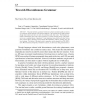Free Online Productivity Tools
i2Speak
i2Symbol
i2OCR
iTex2Img
iWeb2Print
iWeb2Shot
i2Type
iPdf2Split
iPdf2Merge
i2Bopomofo
i2Arabic
i2Style
i2Image
i2PDF
iLatex2Rtf
Sci2ools
104
click to vote
ESSLLI
1999
Springer
1999
Springer
Towards Discontinuous Grammar
This paper presents a grammar formalism in which constituent graphs are unions of a continuous surface tree and a discontinuous deep tree. The formalism has an object-oriented design where nodes have their own rules for combining with other nodes. The formalism includes a deterministic parser with a repair operation as a model of human parsing. The formalism is not a complete theory of grammar: It only determines how global word order follows from a lexical theory specifying local properties like dependency relations, landing sites, and local ordering. This theory of the lexicon and its semantics may be adopted from GB, HPSG, LFG, Word Grammar, Pustejovsky’s Generative Lexicon, or almost any other grammar theory.1 Though languages abound with discontinuous word-order phenomena, most grammar formalisms use continuous syntax trees. This means that discontinuous dependencies must be encoded by some other means than the tree structure. To do so, GB uses movement transformations from deep...
Related Content
| Added | 04 Aug 2010 |
| Updated | 04 Aug 2010 |
| Type | Conference |
| Year | 1999 |
| Where | ESSLLI |
| Authors | Matthias T. Kromann |
Comments (0)

